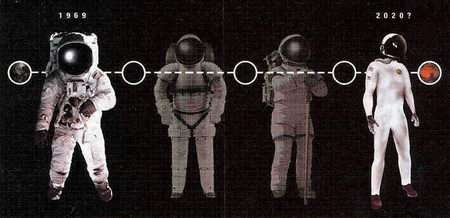February 8, 2006 feature
MIT Researchers Take Space Suit to Next Level

Researchers in the Man Vehicle Laboratory (MVL) at the Massachusetts Institute of Technology have begun this month to push a revolutionary new space suit design from investigation to initial development, aiming for a possible full-scale prototype in as soon as three years.
The new project builds on recent MIT research into an advanced space suit that uses exotic materials and mechanical counter-pressure to create a “second skin,” in contrast to the bulky, inflated “gas bag” models currently used by astronauts. It is funded by a NASA small business technology transfer grant (STTR) and will be conducted in cooperation with the Cambridge Aerospace Company, Midé starting this February.
"A space suit is almost a spacecraft in itself - it provides life support, pressurization, thermal control, micrometeorite protection and other functions necessary to keep the astronaut alive," says Liang Sim, a researcher in the MVL. "Current spacesuits pressurize the body using the breathing gas inside the suit, which limits mobility, complicates functions such as temperature control and moisture removal, and carries the risk of a catastrophic failure in the event of puncture."
The suit being developed by MIT and Midé, by contrast, would use a skin-tight weave of controllable materials to maintain surface pressure. Additional layers could then be added to perform other functions such as radiation protections and temperature control. This could provide more mobility and comfort, increase safety, and lower cost.
“Building a skin-like layer that maintains pressure mechanically allows you to create additional layers that can be donned more like clothing, quickly replaced or repaired.” Says former astronaut and Principle Investigator on the MIT portion of the grant, Jeffrey Hoffman. “This has the potential to revolutionize operations.”
Liang notes that MIT research has already demonstrated that mechanically applied pressure successfully protects humans against exposure to a vacuum. The main challenge now is to ensure that such pressure can be maintained uniformly across the skin, a task that is particularly difficult around joints. Success will likely require advances in two promising areas: mastery of active materials such as “Shape Memory Polymers,” and exploitation of so-called “lines of non-extension” on the human body.
Shape memory polymers are materials that can revert back to specialized shapes when an electric current or other stimulus is applied. They could ensure that pressure stays constant even when the skin is distorted. Lines of non-extension are lines along the human body which do not stretch even when the body is moving. They can be exploited to create a “skeleton” of strong, non-elastic material that does not inhibit movement.
The first phase of the research will therefore focus on mastering the control of shape memory polymers to create uniform pressure along various shapes. The second phase, which may begin in anywhere from six to ten months, will likely create a full-scale mock-up Space Suit. If successful, such suits could be in use for NASA lunar missions next decade and on a first mission to Mars.
By Matthew Silver, Copyright 2006 PhysOrg.com















